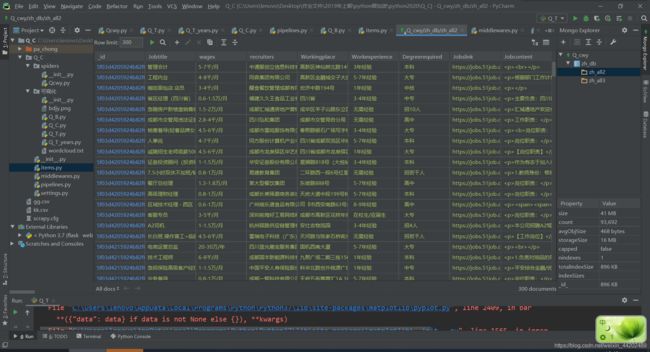python前程无忧scrapy存mogondb案例+可视化显示
一、介绍
python前程无忧scrapy存mogondb案例
接上篇前程无忧案例:spiders和item文件有稍加改动,这里先行奉上啦!
项目结构图:
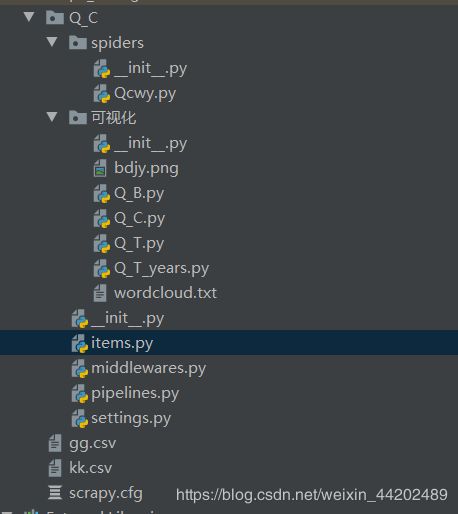
岗位工资对比
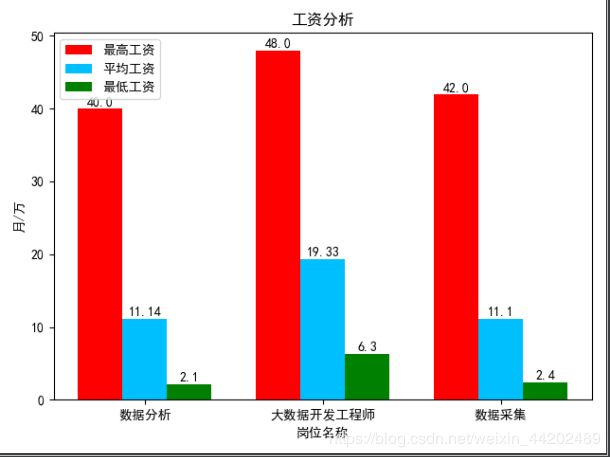
岗位数显示
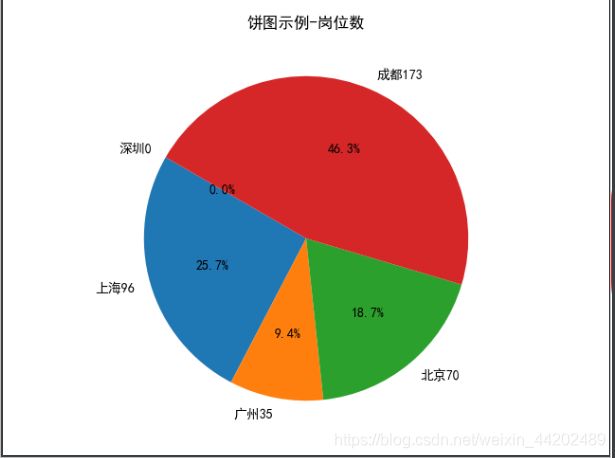
岗位职责词云
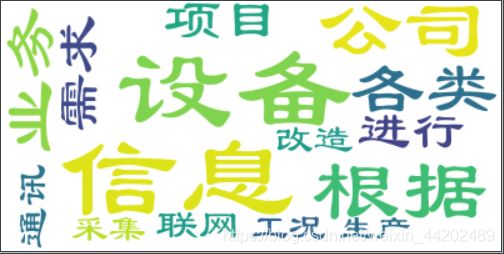
spiders.py
# -*- coding: utf-8 -*-
import scrapy
from Q_C.items import QCItem
class QcwySpider(scrapy.Spider):
name = 'Qcwy'
allowed_domains = ['51job.com']
def start_requests(self):
# 实现翻页
for x in range(1, 15):
#url = "https://search.51job.com/list/090200,000000,0000,00,9,99,大数据,2,{}.html?lang=c&postchannel=0000&workyear=99&cotype=99°reefrom=99&jobterm=99&companysize=99&ord_field=0&dibiaoid=0&line=&welfare=".format(x)
url = "https://search.51job.com/list/000000,000000,0000,00,9,99,%25E6%2595%25B0%25E6%258D%25AE%25E9%2587%2587%25E9%259B%2586,2,{}.html?lang=c&stype=&postchannel=0000&workyear=99&cotype=99°reefrom=99&jobterm=99&companysize=99&providesalary=99&lonlat=0%2C0&radius=-1&ord_field=0&confirmdate=9&fromType=&dibiaoid=0&address=&line=&specialarea=00&from=&welfare=".format(x)
# 将拿到的信息交给parse函数
yield scrapy.Request(url,callback= self.parse)
def parse(self, response):
#获取详情页链接
list = response.xpath('//*[@id="resultList"]/div/p/span/a/@href')
for i in list:
url = i.get()
if url:
print(url)
# # #将详情页拿到的链接交个
yield scrapy.Request(url, callback=self.data)
def data(self,response):
item = QCItem()
# 职位名称
item['Jobtitle']=response.xpath('/html/body/div[3]/div[2]/div[2]/div/div[1]/h1/text()').extract_first()
# 薪资水平
item['wages'] = response.xpath('/html/body/div[3]/div[2]/div[2]/div/div[1]/strong/text()').extract_first()
# 招聘单位
item['recruiters'] = response.xpath('/html/body/div[3]/div[2]/div[4]/div[1]/div[1]/a/p/text()').extract_first()
# 工作地点
item['Workingplace'] = response.xpath('/html/body/div[3]/div[2]/div[3]/div[2]/div/p/text()').extract_first()
# 工作经验
item['Workexperience'] = response.xpath('/html/body/div[3]/div[2]/div[2]/div/div[1]/p[2]/text()[2]').extract_first()
# 学历要求
item['Degreerequired'] = response.xpath('/html/body/div[3]/div[2]/div[2]/div/div[1]/p[2]/text()[3]').extract_first()
# 公司链接
item['Jobslink']=response.xpath('/html/body/div[3]/div[2]/div[4]/div[1]/div[1]/a/@href').extract_first()
# 工作内容
item['Jobcontent'] = response.xpath('/html/body/div[3]/div[2]/div[3]/div[1]/div/p/text()[2]').extract_first()
yield item
items.py
# -*- coding: utf-8 -*-
# Define here the models for your scraped items
#
# See documentation in:
# https://docs.scrapy.org/en/latest/topics/items.html
import scrapy
class QCItem(scrapy.Item):
# define the fields for your item here like:
# name = scrapy.Field()
# 职位名称
Jobtitle=scrapy.Field()
# 薪资水平
wages = scrapy.Field()
# 招聘单位
recruiters = scrapy.Field()
# 工作地点
Workingplace = scrapy.Field()
# 工作经验
Workexperience = scrapy.Field()
# 学历要求
Degreerequired = scrapy.Field()
# 工作内容
Jobcontent = scrapy.Field()
# 公司链接
Jobslink = scrapy.Field()
二、爬取结果示例
三、源码
条形图
import re
import pandas as pd
import pymongo
import matplotlib.pyplot as plt
#连接数据库
myclient = pymongo.MongoClient("mongodb://localhost:27017/")
db = myclient["zh_db"]["zh_all2"]
#拿到爬取的数据
数据分析 = {
"Jobtitle": {"$regex": "数据分析"}
}
大数据开发工程师 = {
"Jobtitle": {"$regex": "大数据开发工程师"}
}
数据采集 = {
"Jobtitle": {"$regex": "数据采集"}
}
#
def show_name(list):
vv = []
for v in list:
name = ''
a = re.findall('[\u4e00-\u9fa5]', str(v))
for i in a:
name += i
vv.append(name)
return vv
#
def show_bar_chart1(xx,cc):
ll = xx
average_Pay_level = []
max_Pay_level = []
min_Pay_level = []
for i in ll:
data = pd.DataFrame(list(db.find(i)))
bb = data['wages'].values
max_Pay_level.append(Pay_level_list(bb)[0])
average_Pay_level.append(Pay_level_list(bb)[1])
min_Pay_level.append(Pay_level_list(bb)[2])
show(max_Pay_level, average_Pay_level, min_Pay_level, cc)
#data为工资列表
# # 统一格式后,输出最大,平均,最小
def Pay_level_list(data):
ww = [".*?千/月", ".*?万/月", ".*?万/年", ".*?元/天"]
Pay_level_list = []
for i in data:
if isinstance(i, str):
for j, v in enumerate(ww):
if re.search(v, i) is not None:
if j == 0:
num = [round(i, 2) for i in
([(i * 12 / 10) for i in (list(map(float, re.findall(r"\d+\.?\d*", i))))])]
elif j == 1:
num = [round(i, 2) for i in
([(i * 12) for i in (list(map(float, re.findall(r"\d+\.?\d*", i))))])]
elif j == 2:
num = [round(i, 2) for i in (list(map(float, re.findall(r"\d+\.?\d*", i))))]
elif j == 3:
num = [round(i, 2) for i in
([(i * 365 / 10000) for i in (list(map(float, re.findall(r"\d+\.?\d*", i))))])]
Pay_level_list.append(num_al(num))
return max(Pay_level_list), tall_num(Pay_level_list), min(Pay_level_list)
def tall_num(list):
num = 0
for i in list:
num += i
return round(num/(len(list)+1), 2)
def num_al(list):
if len(list) >= 2:
num = (list[0] + list[1]) / 2
else:
num = list[0]
return round(num, 2)
#输出条形图
def show(a, b, c, d):
name=d #d = x轴标题(abcd个数要对应)
y1 = a # a = 最高工资列表
y2 = b #b = 平均工资列表
y3 = c #c = 最低工资
x = pd.np.arange(len(name))
width = 0.25
plt.bar(x, y1, width=width, label='最高工资', color='red')
plt.bar(x + width, y2, width=width, label='平均工资', color='deepskyblue', tick_label=name)
plt.bar(x + 2 * width, y3, width=width, label='最低工资', color='green')
# 显示在图形上的值
for a, b in zip(x, y1):
plt.text(a, b + 0.1, b, ha='center', va='bottom')
for a, b in zip(x, y2):
plt.text(a + width, b + 0.1, b, ha='center', va='bottom')
for a, b in zip(x, y3):
plt.text(a + 2 * width, b + 0.1, b, ha='center', va='bottom')
plt.xticks()
plt.legend(loc="upper left") # 防止label和图像重合显示不出来
plt.rcParams['font.sans-serif'] = ['SimHei'] # 用来正常显示中文标签
plt.ylabel('月/万')
plt.xlabel('岗位名称')
plt.rcParams['savefig.dpi'] = 300 # 图片像素
plt.rcParams['figure.dpi'] = 300 # 分辨率
plt.rcParams['figure.figsize'] = (15.0, 8.0) # 尺寸
plt.title("工资分析")
plt.savefig('D:\\result.png')
plt.show()
def yunxing():
xx=[数据分析, 大数据开发工程师, 数据采集]
show_bar_chart1(xx, show_name(xx))
yunxing()
饼图
import re
import matplotlib.pyplot as plt
import pandas as pd
import pymongo
#连接数据库
myclient = pymongo.MongoClient("mongodb://localhost:27017/")
db = myclient["zh_db"]["zh_all2"]
#拿到数据
大数据 = {
"Jobtitle": {"$regex": "大数据"},
"$or":
[
{"Jobtitle": {"$regex": "数据分析"}}, {"Jobtitle": {"$regex": "大数据开发工程师"}}, {"Jobtitle": {"$regex": "数据采集"}}
]
}
上海 = {
"recruiters": {"$regex": "上海"},
"$or":
[
{"Jobtitle": {"$regex": "数据分析"}}, {"Jobtitle": {"$regex": "大数据开发工程师"}}, {"Jobtitle": {"$regex": "数据采集"}}
]
}
北京 = {
"recruiters": {"$regex": "北京"},
"$or":
[
{"Jobtitle": {"$regex": "数据分析"}}, {"Jobtitle": {"$regex": "大数据开发工程师"}}, {"Jobtitle": {"$regex": "数据采集"}}
]
}
广州 = {
"recruiters": {"$regex": "广州"},
"$or":
[
{"Jobtitle": {"$regex": "数据分析"}}, {"Jobtitle": {"$regex": "大数据开发工程师"}}, {"Jobtitle": {"$regex": "数据采集"}}
]
}
成都 = {
"recruiters": {"$regex": "成都"},
"$or":
[
{"Jobtitle": {"$regex": "数据分析"}}, {"Jobtitle": {"$regex": "大数据开发工程师"}}, {"Jobtitle": {"$regex": "数据采集"}}
]
}
深圳 = {
"recruiters": {"$regex": "深圳"},
"$or":
[
{"Job_title": {"$regex": "数据分析"}}, {"Job_title": {"$regex": "大数据开发工程师"}}, {"Job_title": {"$regex": "数据采集"}}
]
}
def show_name(list):
vv = []
for v in list:
name = ''
a = re.findall('[\u4e00-\u9fa5]', str(v))
for i in a:
name += i
vv.append(name)
return vv
def pie_chart(list1):
city = list1
city1 = []
city2 = []
for i in city:
city1.append(i["recruiters"])#拿到公司名
mm = show_name(city1)
for j, v in enumerate(city):
bb = len(pd.DataFrame(list(db.find(v))))
city2.append(bb)
mm[j] += str(bb)
plt.rcParams['font.sans-serif'] = ['SimHei'] # 用来正常显示中文标签
sizes = city2
# explode = (0.1, 0, 0, 0, 0)
plt.pie(sizes, labels=mm, autopct='%1.1f%%', shadow=False, startangle=150) # 想要突出
plt.title("饼图示例-岗位数")
plt.show()
def yunxing():
city = [上海, 广州, 北京, 成都, 深圳]
pie_chart(city)
yunxing()
词云图
import re
import jieba
import pandas as pd
import pymongo
import wordcloud
#连接数据库
myclient = pymongo.MongoClient("mongodb://localhost:27017/")
db = myclient["zh_db"]["zh_all2"]
#拿到数据
CJ = {
"Jobtitle": {"$regex": "数据采集"}
}
#
def yunxing():
data = pd.DataFrame(list(db.find(CJ)))
bb = data['Jobcontent'].values
for i in bb:
if type(i) == str:
filename = 'wordcloud.txt'
with open(filename, 'w') as file_object:
for i in jieba.lcut(i):
a = re.findall('[\u4e00-\u9fa5]', i)
if a:
name = ''
for i in a:
name += i
file_object.write(name+' ')
mywordcloud = wordcloud.WordCloud(font_path="/Library/Fonts/SIMLI.TTF")
wf = open("wordcloud.txt", "r").read()
mywordcloud.generate_from_text(wf)
mywordcloud.background_color = "white"
mywordcloud.to_file("bdjy.png")
yunxing()
注意:词云图有点问题,分词有点问题,使用时劳烦微调啦!!
